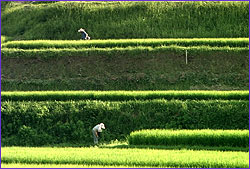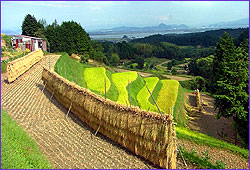 |
 |
Miracle of Rice
by Lexi Krock
You've probably never stopped to consider rice for any longer than it takes to trap a piece of sushi between your chopsticks. But this humble grain is truly remarkable. In Asia, for example, it provides 50 to 80 percent of people's daily caloric intake. And rice is getting more remarkable by the year. A series of advances in biotechnology have paved the way for high-yield rice varieties resistant to blights and bugs and fortified with vitamin A. With at least a million children weakened by vitamin-A deficiency every year and an additional 350,000 going blind, the possibility that genetically engineered rice may soon be widely available in Asia and Africa makes rice seem nothing short of miraculous.
Origins
A Malaysian aboriginal myth holds that all of the sky once lay flat on the Earth in the form of rice until the women of the tribe, wielding their long wooden rice brooms, heaved it upwards in the first harvest. From then on, rice fell back to Earth each year in time for a bountiful harvest.
Rice's evolutionary origins go far back into history, so far that scientists can only make intelligent guesses as to where the rice genus (Oryza) first grew. One theory maintains that rice arose in the ancient supercontinent known as Gondwana. Then, when Gondwana fragmented into Africa, South America, Antarctica, Australia/New Zealand, India, and Madagascar beginning about 200 million years ago, Oryza went with the fragments.
 Farmers must incessantly weed rice paddies to maintain water flow through the terraces.
Farmers must incessantly weed rice paddies to maintain water flow through the terraces.
|
|
Rice, an annual grass belonging to the same family as barley, oats, rye, and wheat, grows today in a range of habitats almost unparalleled in the plant kingdom. It is cultivated in the cool Himalayan climates of Nepal and in the scorching deserts of Pakistan, Iran, and Egypt. In Latin America it grows as a dry-land crop, in Southeast Asia as a paddy crop watered by monsoon rains and floodwater. All told, some 358 million acres, or roughly 11 percent of the world's arable land, are given over to rice cultivation, according to the International Rice Research Institute (IRRI) in the Philippines.
Raising rice
Rice-growing methods are almost as varied as the grain's geographical habitats. In the United States, farmers use highly mechanized systems, but in most developing nations, rice farming remains extremely labor-intensive. The work is backbreaking and relentless, and in Japan and other Asian countries where farmers tend terraced paddies, it is also muddy.
Paddy rice is irrigated by water diverted from rivers and mountain streams into a complex system of canals and riverways developed and perfected through centuries of use. Terracing, which requires constant maintenance, allows water to flow continuously down through successive rice fields (see Build a Rice Paddy). Farmers usually plant rice seed in a seedbed, then transplant young plants into the paddies, which have about six inches of water at this stage. As the plants mature, cultivators allow the water level in the field to drop. By the time the plants reach full maturity, the ground is entirely dry, and farmers can easily harvest the rice.
|  At Lake Biwa, farmers place bundles of harvested rice out to dry in the sun before they begin threshing.
At Lake Biwa, farmers place bundles of harvested rice out to dry in the sun before they begin threshing.
|
Harvesters cut the ripe grain from the stalk and then, after it has dried, thresh it to separate the grains from the so-called rice straw. In Asia, oxen typically do the threshing by trampling the rice laid out before them. Milling then removes each grain's hull to reveal the part of the rice plant that eventually ends up in our mouths. Milling both the hull and bran layers of the kernel renders so-called white rice; brown rice retains the bran. After the harvest, farmers turn over the soil, readying the paddy for another season.
The role rice plays in national culture varies dramatically depending on where you are. Most Americans, for example, view rice as just another commodity available on supermarket shelves. But in Japan, o-kome, or "honorable rice," is much more than a commodity. In the Shinto religion, sake, rice cakes, and other rice products are the most sacred of offerings, and to a nation that must import most of its meat, fish, and fruit, rice is a symbol of independence. Indeed, as a matter of tradition, the Japanese government strictly prohibits the import of rice as long as local crops provide harvests bountiful enough to satisfy the national appetite.
Continue: Rice crisis
Animal Transformations |
Miracle of Rice
Secrets of Hibernation |
Build a Rice Paddy |
Resources
Transcript |
Site Map |
Japan's Secret Garden Home
Editor's Picks |
Previous Sites |
Join Us/E-mail |
TV/Web Schedule
About NOVA |
Teachers |
Site Map |
Shop |
Jobs |
Search |
To print
PBS Online |
NOVA Online |
WGBH
© | Updated December 2000
|
|
|